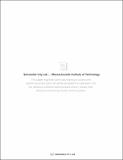| dc.contributor.author | Tian, Ye | |
| dc.contributor.author | deSouza, Priyanka | |
| dc.contributor.author | Mora, Simone | |
| dc.contributor.author | Yao, Xiaobai | |
| dc.contributor.author | Duarte, Fabio | |
| dc.contributor.author | Norford, Leslie K | |
| dc.contributor.author | Lin, Hui | |
| dc.contributor.author | Ratti, Carlo | |
| dc.date.accessioned | 2022-09-26T17:08:38Z | |
| dc.date.available | 2022-09-26T17:08:38Z | |
| dc.date.issued | 2022 | |
| dc.identifier.uri | https://hdl.handle.net/1721.1/145571 | |
| dc.description.abstract | Predictive models based on mobile measurements have been increasingly used to understand the spatiotemporal variations of intraurban air quality. However, the effects of meteorological factors, which significantly affect the dispersion of air pollution, on the urban-form-air-quality relationship have not been understood on a granular level. We attempt to fill this gap by developing predictive models of particulate matter (PM) in the Bronx (New York City) using meteorological and urban form parameters. The granular PM data was collected by mobile low-cost sensors as the ground truth. To evaluate the effects of meteorological factors, we compared the performance of models using the urban form within fixed and wind-sensitive buffers, respectively. We find better predictive power in the wind-sensitive group (R = 0.85) for NC10 (number concentration for particles with diameters of 1 μm-10 μm) than the control group (R = 0.01), and modest improvements for PM2.5 (R = 0.84 for the wind sensitive group, R = 0.77 for the control group), indicating that incorporating meteorological factors improved the predictive power of our models. We also found that urban form factors account for 62.95% of feature importance for NC10 and 14.90% for PM2.5 (9.99% and 4.91% for 3-D and 2-D urban form factors, respectively) in our Random Forest models. It suggests the importance of incorporating urban form factors, especially for the uncommonly used 3-D characteristics, in estimating intraurban PM. Our method can be applied in other cities to better capture the influence of urban context on PM levels. | en_US |
| dc.language.iso | en | |
| dc.publisher | American Chemical Society (ACS) | en_US |
| dc.relation.isversionof | 10.1021/ACS.EST.1C04854 | en_US |
| dc.rights | Creative Commons Attribution-Noncommercial-Share Alike | en_US |
| dc.rights.uri | http://creativecommons.org/licenses/by-nc-sa/4.0/ | en_US |
| dc.source | MIT web domain | en_US |
| dc.title | Evaluating the Meteorological Effects on the Urban Form–Air Quality Relationship Using Mobile Monitoring | en_US |
| dc.type | Article | en_US |
| dc.identifier.citation | Tian, Ye, deSouza, Priyanka, Mora, Simone, Yao, Xiaobai, Duarte, Fabio et al. 2022. "Evaluating the Meteorological Effects on the Urban Form–Air Quality Relationship Using Mobile Monitoring." Environmental Science and Technology, 56 (11). | |
| dc.contributor.department | Massachusetts Institute of Technology. Department of Architecture | en_US |
| dc.relation.journal | Environmental Science and Technology | en_US |
| dc.eprint.version | Author's final manuscript | en_US |
| dc.type.uri | http://purl.org/eprint/type/JournalArticle | en_US |
| eprint.status | http://purl.org/eprint/status/PeerReviewed | en_US |
| dc.date.updated | 2022-09-26T16:58:53Z | |
| dspace.orderedauthors | Tian, Y; deSouza, P; Mora, S; Yao, X; Duarte, F; Norford, LK; Lin, H; Ratti, C | en_US |
| dspace.date.submission | 2022-09-26T16:58:57Z | |
| mit.journal.volume | 56 | en_US |
| mit.journal.issue | 11 | en_US |
| mit.license | OPEN_ACCESS_POLICY | |
| mit.metadata.status | Authority Work and Publication Information Needed | en_US |
